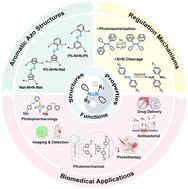生物医学用芳香偶氮光活性小分子的合理结构设计
IF 39
1区 化学
Q1 CHEMISTRY, MULTIDISCIPLINARY
引用次数: 0
摘要
芳香偶氮分子,包括偶氮苯(Ph-NN-Ph)和杂芳基偶氮(Het-NN-Ph或Het-NN-Het),已经成为生物医学应用的多功能和高性能光活性开关。尽管对芳香偶氮作为分子光开关进行了数十年的广泛研究,但这些小分子的全部转化潜力仍未得到充分开发。本文系统地概述了芳香偶氮化合物的结构设计策略,从功能取代基工程到π共轭调制,以微调其光物理性质。本文总结了合成多功能芳香偶氮框架的最新合成方法,对比了偶氮苯和杂芳基偶氮衍生物的异构化机制,并重点介绍了最新的生物医学应用进展,包括生物成像和检测、药物递送、光药理学、光疗、杂项光反应生物材料和结构,以及化学生物学中的控制。此外,我们还讨论了该领域的临床翻译挑战和机遇,并提出了解决关键问题的创新策略。本文综述了芳香族偶氮光活性小分子在生物医学领域的应用。本文章由计算机程序翻译,如有差异,请以英文原文为准。

Rational structural design of aromatic Azo photoactive small molecules for biomedical applications
Aromatic Azo molecules, including azobenzenes (Ph–N![[double bond, length as m-dash]](https://www.rsc.org/images/entities/char_e001.gif) N–Ph) and heteroaryl Azo (Het–N
N–Ph) and heteroaryl Azo (Het–N![[double bond, length as m-dash]](https://www.rsc.org/images/entities/char_e001.gif) N–Ph or Het–N
N–Ph or Het–N![[double bond, length as m-dash]](https://www.rsc.org/images/entities/char_e001.gif) N–Het), have emerged as versatile and high-performing photoactive switches for biomedical applications. Despite decades of extensive research on aromatic Azo as molecular photoswitches, the full translational potential of these small molecules remains underexploited. This review systematically outlines structural design strategies for aromatic Azo, spanning from functional substituent engineering to π-conjugation modulation, to fine-tune its photophysical properties. We summarize state-of-the-art synthetic methodologies for crafting multifunctional aromatic Azo frameworks, contrast the distinct isomerization mechanisms of azobenzenes versus heteroaryl Azo derivatives, and highlight the latest biomedical application advances, including biological imaging and detection, drug delivery, photopharmacology, phototherapy, miscellanea photo responsive biomaterials and constructs, and control in chemical biology. Furthermore, we discuss clinical translation challenges and opportunities in this field, proposing innovative strategies to address critical issues. This review aims to substantially advance the burgeoning field of aromatic Azo photoactive small molecules for biomedical applications.
N–Het), have emerged as versatile and high-performing photoactive switches for biomedical applications. Despite decades of extensive research on aromatic Azo as molecular photoswitches, the full translational potential of these small molecules remains underexploited. This review systematically outlines structural design strategies for aromatic Azo, spanning from functional substituent engineering to π-conjugation modulation, to fine-tune its photophysical properties. We summarize state-of-the-art synthetic methodologies for crafting multifunctional aromatic Azo frameworks, contrast the distinct isomerization mechanisms of azobenzenes versus heteroaryl Azo derivatives, and highlight the latest biomedical application advances, including biological imaging and detection, drug delivery, photopharmacology, phototherapy, miscellanea photo responsive biomaterials and constructs, and control in chemical biology. Furthermore, we discuss clinical translation challenges and opportunities in this field, proposing innovative strategies to address critical issues. This review aims to substantially advance the burgeoning field of aromatic Azo photoactive small molecules for biomedical applications.
![[double bond, length as m-dash]](https://www.rsc.org/images/entities/char_e001.gif) N–Ph) and heteroaryl Azo (Het–N
N–Ph) and heteroaryl Azo (Het–N![[double bond, length as m-dash]](https://www.rsc.org/images/entities/char_e001.gif) N–Ph or Het–N
N–Ph or Het–N![[double bond, length as m-dash]](https://www.rsc.org/images/entities/char_e001.gif) N–Het), have emerged as versatile and high-performing photoactive switches for biomedical applications. Despite decades of extensive research on aromatic Azo as molecular photoswitches, the full translational potential of these small molecules remains underexploited. This review systematically outlines structural design strategies for aromatic Azo, spanning from functional substituent engineering to π-conjugation modulation, to fine-tune its photophysical properties. We summarize state-of-the-art synthetic methodologies for crafting multifunctional aromatic Azo frameworks, contrast the distinct isomerization mechanisms of azobenzenes versus heteroaryl Azo derivatives, and highlight the latest biomedical application advances, including biological imaging and detection, drug delivery, photopharmacology, phototherapy, miscellanea photo responsive biomaterials and constructs, and control in chemical biology. Furthermore, we discuss clinical translation challenges and opportunities in this field, proposing innovative strategies to address critical issues. This review aims to substantially advance the burgeoning field of aromatic Azo photoactive small molecules for biomedical applications.
N–Het), have emerged as versatile and high-performing photoactive switches for biomedical applications. Despite decades of extensive research on aromatic Azo as molecular photoswitches, the full translational potential of these small molecules remains underexploited. This review systematically outlines structural design strategies for aromatic Azo, spanning from functional substituent engineering to π-conjugation modulation, to fine-tune its photophysical properties. We summarize state-of-the-art synthetic methodologies for crafting multifunctional aromatic Azo frameworks, contrast the distinct isomerization mechanisms of azobenzenes versus heteroaryl Azo derivatives, and highlight the latest biomedical application advances, including biological imaging and detection, drug delivery, photopharmacology, phototherapy, miscellanea photo responsive biomaterials and constructs, and control in chemical biology. Furthermore, we discuss clinical translation challenges and opportunities in this field, proposing innovative strategies to address critical issues. This review aims to substantially advance the burgeoning field of aromatic Azo photoactive small molecules for biomedical applications.
求助全文
通过发布文献求助,成功后即可免费获取论文全文。
去求助
来源期刊

Chemical Society Reviews
化学-化学综合
CiteScore
80.80
自引率
1.10%
发文量
345
审稿时长
6.0 months
期刊介绍:
Chemical Society Reviews is published by: Royal Society of Chemistry.
Focus: Review articles on topics of current interest in chemistry;
Predecessors: Quarterly Reviews, Chemical Society (1947–1971);
Current title: Since 1971;
Impact factor: 60.615 (2021);
Themed issues: Occasional themed issues on new and emerging areas of research in the chemical sciences
 求助内容:
求助内容: 应助结果提醒方式:
应助结果提醒方式:


